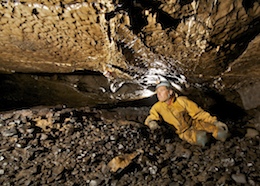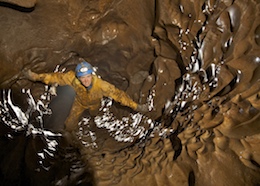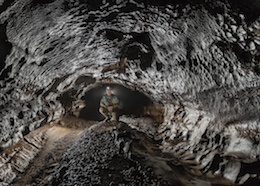Overview
Tooth Cave is one of the longest on Gower and in dry settled weather viewing the fine scalloped walls of the main stream passage makes the journey to this remote cave well worthwhile.Length 1,550m
Altitude 50m
Grid SS 53166 90953
History
The cave was first explored by the South Wales Caving Club in 1961.
Location
Following the B4271 from Swansea to Llanrhidian a public footpath is found on a bend just before Llethryd Bridge. Follow the footpath down the Green Cwm and the cave is found in trees at the base of a small cliff in the side of a clearing and is gated. Gower Peninsular Google map showing the location of Tooth Cave and other caves in the area.
Location map - click marker to show entrance photo
Access
The cave is gated with the access controlled by the South Wales Caving Club.See Cambrian Caving Council for details
Description
The low entrance passage leads to a narrow slot that drops down to the top of the 5m ladder pitch into Bone Chamber. Once in the chamber a climb up to the left of the pitch (looking at it) leads via an inclined rift to Boulder Chamber where the way on is through the boulders in the floor. This leads to the top of a 4m climb down the inclined rift to reach a series of crawls that lead back into more rift passage for about 20m. Beyond this, a series of crawls are followed past a bend with small pool and at the other side of it, through Stal Squeeze. The way on is ahead via these cobble and mud floored crawls passing the inlet from Razor Passage on the left.Razor passage can be followed for 250 metres until it ends in a small chamber with small gravel choked passages leading off at the bottom.
Past the junction with Razor Passage the route continues through some wide cobble floored passages to a 3m drop with a low crawl off to the right at it's bottom. This low section leads into bigger passage with the 30m long Diver's Delight passage leading off to the right. The way on is ahead past the Elephant's Legs formations after which the passage becomes more filled with cobbles as you go through Pebble Crawl and eventually emerge into the Main Stream Passage. This final section of cobble filled passage may require a little digging to allow you to get through as the cobbles rearrange after rain.
To the right is the upstream section of the cave, where the wide, low cobble and mud floored passage soon becomes a little higher, and the cobbles give way to sections of deeply scalloped limestone. The passage continues as a stooping and walking passage until a climb down a 4m deep pot leads you to a landing where in two places you can see down into a rift and the deep blue waters of Top Sump.
From the entrance to the Main Stream Passage following the downstream route, the passage continues low and wide over cobbles, meandering as a series of crawls and stooping passage until the bottom of a large boulder collapse is reached after 160m. A climb up the boulders leads to a large aven, where a climb up through boulders at the higher end leads through into the Aven Series (60m of low dry passages). From the bottom of the boulder collapse the passage continues on to the Big Sump. This 20m sump dries up after long dry spells and gives entry to the extensive and impressive lower downstream section of the cave. Beyond the sump the passage dimensions increase and you are able to walk in most sections of the passage. A large straight section of rift passage - The Knave, leads through into some large chambers. The final major chamber contains a large mud and sand bank that is capped with a white topping of calcite flow - the Christmas Cake. After passing through Christmas Cake Chamber the passage quickly changes character and becomes more rifty. The passage starts to spilt off into different routes with two main rift passages leading off to narrow traverses over the final narrow rift sumps. In this area there are a series of phreatic tubes at roof level that can be followed. The main one leading after some distance to a drop down into a sand and gravel choked sump.
Tackle
Entrance pitch 5m - Belay from three hangers in-situ
References
Cambrian Cave Registry for Tooth Cave UK Caving Wiki Entry for Tooth Cave
Caves of South Wales | Tim Stratford | ISBN: 1-871890-03-9 | Published by Cordee
Selected Caves of Britain and Ireland | Des Marshall - Donald Rust | ISBN: 1-871890-43-8 | Cordee
Caves of the Gower | Tony Oldham.
Warnings
This cave should only be visited in settled weather as it rapidly floods following rain.
Disclaimer
The photographs and information of this page has been provided to help cavers planning trips. Caving can be a dangerous activity, if you are interested in exploring caves please join a caving club so you can enjoy a safe introduction to this sport. Local caving clubs are listed on the links page or you can visit the 'New To Caving' website for more options.If you feel that any of the information is incorrect or should be updated please contact us.








